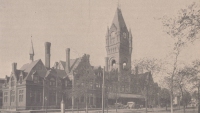|
Three men come into more
prominent view at this time. One is Russell Sage, a New York financier who
was to have many fingers in many things during these years, including
fingers in many railroads.
Associated with him were
Alexander Mitchell, president of the St. Paul, and Sherburn S. Merrill,
who, for years, was to be the general manager in charge of operating the
Milwaukee & St. Paul.
Mitchell, a Scottish
immigrant, had come to the U.S. as a young man, arriving in America in
1838 and in Milwaukee in 1839. He went to Wisconsin as the representative
of a Chicago banker, but soon took over the whole business, becoming
Milwaukee’s leading banker.
 Mitchell was a part of
virtually every early day railroad formed in Wisconsin, whether acting
openly as a director or banker, or as an informal advisor. He was on the
Milwaukee & Mississippi board from 1849 to 1855 and again in 1858, had
been a commissioner of the Milwaukee & Watertown, a director of the La
Crosse & Milwaukee and trustee of the small Milwaukee & Western railroad. Mitchell was a part of
virtually every early day railroad formed in Wisconsin, whether acting
openly as a director or banker, or as an informal advisor. He was on the
Milwaukee & Mississippi board from 1849 to 1855 and again in 1858, had
been a commissioner of the Milwaukee & Watertown, a director of the La
Crosse & Milwaukee and trustee of the small Milwaukee & Western railroad.
Mitchell and his associates
saw the chance to build a large, unified system from the small railroads
that had been broken by the panic, and they moved to gather up a number of
these lines.
Eventually there would be
more than 200 corporate entities going to make up the corporation that now
is the Milwaukee Road. In those early days, many were railroad companies
that had systems of no more than 30, 40 or 50 miles of track. Some were
shorter; the Ripon and Wolf River Railroad Co., had 9.56 miles, the Pine
River Valley & Stevens Point Rail Road Co. had 16.22 miles between Lone
Rock and Richland Center, the Stillwater & Hastings Railway had 2.00
miles— in other words, some had corporate names nearly as long as their
trackage.
Mitchell’s basic structure
came from the La Crosse & Milwaukee. From that, he moved to arrange a
working agreement with the Milwaukee & Prairie du Chien (the former
Milwaukee & Mississippi) in 1865. Then in 1866 Mitchell became a director
of the Prairie du Chien and the next year was elected its president,
merging it with the La Crosse.
This also brought the
McGregor Western under control of Mitchell and Sage, because this line had
been leased in 1865 by the Prairie du Chien.
The McGregor Western was an
important addition. It had one end in McGregor, Ia., just across the
Mississippi River from Prairie du Chien, where the old M&M ended. The
other end of the McGregor reached nearly to Minneapolis-St. Paul, this
line being finished under Milwaukee & St. Paul management in 1867. The
line from Milwaukee to the Twin Cities went by way of Cresco, Ia., and
Owatonna, Minn., crossing the river, of course, at Prairie du Chien.
By 1868, the Milwaukee & St.
Paul was a railroad with 825 miles of track, 135 locomotives, more than
130 units of passenger equipment and more than 2,400 freight cars. It was
a big railroad for the era, but Mitchell and his associates were just
beginning. *
* (As a note of historical
interest and curiosity, but not much significance, it was at this time, in
1869, that Mitchell served for a short while as president of both the
Milwaukee & St. Paul and of the Chicago & North Western, a railroad
growing as fast in Illinois and southern Wisconsin as the M&StP was
elsewhere in the Wisconsin area.) |
|
|
Alexander Mitchell |
